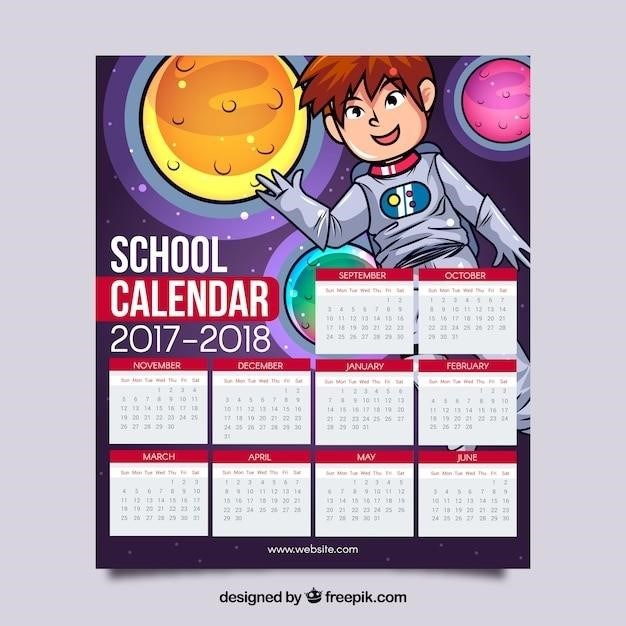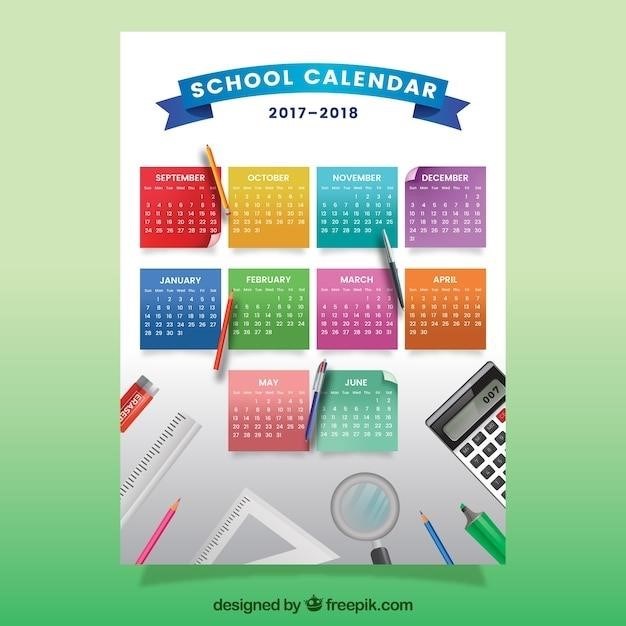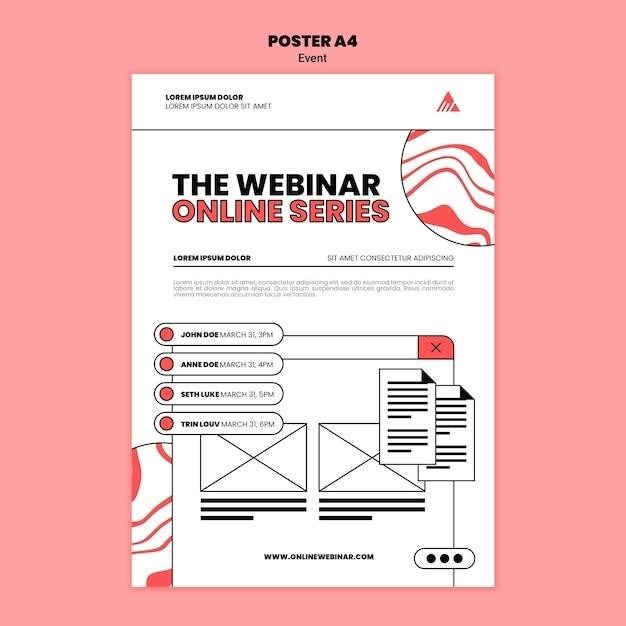Prosper ISD School Calendar 2024-2025⁚ Key Dates and Information
The Prosper ISD school calendar for the 2024-2025 school year is now available online and provides important dates and information for parents, students, and staff. The first day of school for students is August 13, 2024, and the last day is May 23, 2025.
First Day of School and Important Dates
The Prosper ISD school calendar for the 2024-2025 school year provides a comprehensive overview of key dates and events throughout the academic year. The first day of school for students is scheduled for August 13, 2024, marking the beginning of a new academic journey for students in the district.
The calendar also outlines various important dates throughout the year, including holidays, breaks, and professional development days for staff. The school calendar is designed to ensure that all stakeholders have a clear understanding of the academic schedule and can plan their activities accordingly.
The Prosper ISD school calendar is a valuable resource for parents, students, and staff alike. It provides a clear and concise overview of the academic year, allowing everyone to stay informed and prepared for the upcoming school year. The calendar can be accessed online via the Prosper ISD website, ensuring easy accessibility for all members of the school community.
Fall Break and Winter Break
The Prosper ISD school calendar for the 2024-2025 school year provides specific details regarding fall break and winter break, allowing students, teachers, and families to plan for these periods of respite from the regular school schedule. The fall break is a designated time for students and staff to take a break from their academic responsibilities and enjoy time with family and friends.
The winter break, often referred to as the holiday break, is a more extended period of time for students and staff to rest and recharge during the holiday season. The calendar outlines the exact dates for both fall break and winter break, ensuring that everyone is aware of the time off and can make necessary arrangements.
The Prosper ISD school calendar is designed to provide a balanced academic year, incorporating breaks and holidays to allow students and staff to enjoy time outside of the classroom. The calendar is an essential tool for families to plan their activities and events around the school schedule, ensuring that everyone can make the most of these important breaks.
Spring Break and Last Day of School
The Prosper ISD school calendar for the 2024-2025 school year details the dates for spring break, a time for students and staff to recharge and enjoy a break from the school routine. The calendar clearly indicates the specific dates for spring break, allowing families to plan vacations, trips, or simply enjoy some quality time together. Spring break is a vital part of the school calendar, providing a much-needed respite from the rigors of academics and a chance for students to explore interests outside of the classroom.
In addition to spring break, the calendar also highlights the last day of school for the 2024-2025 school year. The last day of school marks the end of another academic year and the beginning of summer vacation. The date for the last day of school is prominently featured on the calendar, allowing students, parents, and staff to anticipate the upcoming summer break and plan accordingly. The last day of school is a significant event in the school year, signifying the culmination of months of hard work and dedication.
The Prosper ISD school calendar is designed to provide clear and concise information regarding key dates and events, including spring break and the last day of school. This information enables families and staff to effectively plan their schedules and make the most of these important milestones in the academic year.
Prosper ISD Calendar Features
The Prosper ISD school calendar for the 2024-2025 school year is designed with user-friendliness in mind, offering a range of features to enhance accessibility and informativeness. The calendar is readily available online, allowing easy access for parents, students, and staff. Its digital format enables convenient viewing and sharing, ensuring that everyone is well-informed about important dates and events. The calendar’s layout is clear and concise, with key dates and events highlighted for easy identification. This structure helps users quickly locate the information they need, saving time and effort.
The Prosper ISD calendar goes beyond simply listing dates; it provides valuable context for each entry. For instance, holidays, breaks, and professional development days are clearly labeled, offering a comprehensive understanding of the school year’s rhythm. The calendar also incorporates details about early release days, ensuring that parents are aware of adjusted school schedules and can plan accordingly. This level of detail demonstrates a commitment to transparency and communication, fostering a collaborative and informed school community.
The Prosper ISD school calendar serves as a vital tool for coordinating activities, planning events, and staying informed throughout the school year. Its user-friendly features and comprehensive information contribute to a smooth and efficient educational experience for everyone involved.
School Times and Calendar Access
The Prosper ISD school calendar provides comprehensive information about school times for different grade levels, ensuring a consistent and organized learning environment. High school students follow a schedule of 8⁚45 AM to 4⁚10 PM, while middle school students attend classes from 8⁚15 AM to 3⁚30 PM. Elementary school students have a daily schedule of 7⁚45 AM to 3⁚00 PM, providing a balanced and age-appropriate learning experience. For early childhood students, the school offers two half-day options⁚ AM half-day from 7⁚30 AM to 10⁚41 AM and PM half-day from 11⁚34 AM to 2⁚45 PM, catering to the unique needs of younger learners.
Access to the Prosper ISD school calendar is conveniently available online, ensuring that parents, students, and staff can easily stay informed about important dates and events. The digital format allows for easy viewing and sharing, ensuring that everyone has access to the necessary information. The calendar’s user-friendly interface provides a clear and concise layout, with key dates and events highlighted for quick identification.
The Prosper ISD school calendar is a valuable resource for navigating the school year, providing clear information about school times and offering convenient access to important dates and events. This online platform fosters a sense of community and ensures that everyone is well-informed about the school year’s schedule.
Prosper ISD Enrollment and Registration
Prosper ISD is committed to providing a seamless enrollment and registration process for all students, ensuring a smooth transition into the school year. Enrollment and registration are currently open for both new and returning students for the upcoming 2024-2025 school year. This comprehensive process ensures that all students are properly registered and prepared for the academic year ahead.
To ensure a smooth enrollment experience, Prosper ISD encourages all parents and guardians to complete the registration process promptly. The district provides detailed instructions and support to guide families through the registration process, making it easy and convenient. This proactive approach ensures that all students have the necessary documentation and information readily available for a successful start to the school year.
Prosper ISD’s commitment to efficient enrollment and registration reflects its dedication to providing a welcoming and supportive environment for all students. By streamlining the registration process, the district aims to make the transition into school a positive and stress-free experience for both students and families. This focus on efficiency and accessibility ensures that all students have the opportunity to thrive in Prosper ISD’s dynamic and engaging learning environment.
Prosper ISD Bond Program and Updates
Prosper ISD’s commitment to providing exceptional educational experiences for its students is evident in its ongoing bond program. This program, approved by voters, aims to address the district’s growth and evolving needs by funding essential infrastructure improvements and upgrades. These investments are crucial for ensuring that Prosper ISD can continue to offer a high-quality education to its growing student population.
The bond program encompasses a range of projects designed to enhance facilities, improve technology, and create a more robust learning environment. These projects include the construction of new schools, the expansion of existing facilities, and the implementation of cutting-edge technology to support student learning. This proactive approach ensures that Prosper ISD remains at the forefront of educational innovation, providing students with access to the resources they need to succeed.
Regular updates on the bond program’s progress are provided to the community, ensuring transparency and accountability. These updates highlight the positive impact of the bond program on students, staff, and the overall community. By keeping residents informed, Prosper ISD fosters a sense of shared ownership in the district’s growth and development. The bond program serves as a testament to Prosper ISD’s commitment to providing a world-class education for all students, ensuring a bright future for the community.
Prosper ISD Academic Calendar Approval Process
The Prosper ISD academic calendar is a meticulously crafted document that serves as a roadmap for the entire school year. Its creation and approval involve a collaborative and comprehensive process that ensures it meets the needs of students, staff, and the community.
This process typically begins with input from various stakeholders. Teachers, administrators, parents, and community members are invited to provide feedback on potential calendar options, ensuring that diverse perspectives are considered. This input helps shape the calendar, ensuring it aligns with the educational priorities of the district and the needs of its diverse community.
After gathering input, the calendar is carefully reviewed and refined by a committee composed of district representatives. This committee analyzes the feedback, considers logistical considerations, and ultimately proposes a calendar that balances educational needs with the well-being of students and staff. The proposed calendar is then presented to the Prosper ISD Board of Trustees for final approval.
This multi-faceted process ensures that the final calendar reflects the collective voice of the community, serving as a foundation for a successful and enriching school year for all.
Community Input and Feedback
Prosper ISD values community involvement in shaping the academic calendar, recognizing that it directly impacts the lives of students, families, and staff. The district actively seeks feedback from various community members, including parents, teachers, and community leaders, to ensure the calendar aligns with their needs and priorities.
This input is crucial in determining key dates, such as the first and last days of school, holidays, and breaks. The district encourages community members to participate in open forums, surveys, and online platforms designed to gather feedback on proposed calendar options.
By engaging the community in this collaborative process, Prosper ISD aims to create a calendar that is not only practical and efficient but also supportive of the educational and social needs of its diverse community. This open and inclusive approach fosters a sense of shared ownership and ensures that the calendar effectively serves the entire Prosper ISD community.
Prosper ISD School Calendar Download
For easy reference and planning, the Prosper ISD school calendar for the 2024-2025 school year is readily available for download in a PDF format. The PDF document provides a comprehensive overview of all important dates, including the first and last days of school, holiday breaks, teacher work days, and other significant events.
Parents, students, and staff can conveniently download the calendar directly from the Prosper ISD website; This digital format allows for easy access, printing, and sharing. The PDF download ensures that everyone has a readily available resource for staying informed about the school year’s schedule.

The Prosper ISD website also provides additional resources, such as a link to the district’s online calendar, which features a more interactive and detailed view of events. This comprehensive approach ensures that the community has multiple avenues for accessing and utilizing the school calendar throughout the year.
Prosper ISD School Calendar on Social Media

Staying informed about school events and important dates is made easier with Prosper ISD’s active presence on social media platforms. The district utilizes social media channels to share updates, announcements, and reminders about the school calendar.
Parents, students, and community members can follow Prosper ISD on Facebook, Twitter, and other platforms to receive timely notifications about school closures, holiday breaks, and other significant events. Social media provides a convenient and accessible platform for staying up-to-date on the school calendar.
The district’s social media presence also allows for two-way communication, enabling community members to ask questions, provide feedback, and engage in discussions about the school calendar. This interactive approach fosters a sense of community and ensures that everyone has a voice in shaping the school year’s schedule.
Prosper ISD Website and Contact Information
The Prosper ISD website serves as a comprehensive resource for information about the district, including the official school calendar. Parents, students, and the community can access the 2024-2025 school calendar directly on the website, along with additional details about school events, holidays, and important dates. The calendar is typically available in a downloadable PDF format for easy printing and reference.
The website also provides contact information for various departments within Prosper ISD, enabling individuals to reach out with questions or concerns related to the school calendar or other district matters. This includes contact details for the superintendent’s office, school principals, and specific departments like enrollment and registration.
In addition to the website, Prosper ISD provides contact information through its social media channels, ensuring that community members have multiple avenues for reaching out to the district. This accessibility promotes transparency and facilitates communication between the district and its stakeholders.


























